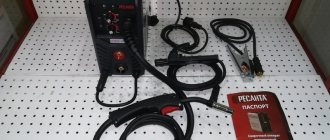What it is
MRV bulbs stand for mercury tungsten arc bulbs, they are very famous among buyers. They are made in the largest industrial factories.
Size options
It is difficult for inexperienced people to visually distinguish DVR and DRL bulbs. The differences lie in their technical features. In the design of these light bulbs you can see:
- Base. A part that receives electricity from the network due to the connection of the contacts of the socket and the light bulb;
- Quartz vessel. It must be filled with argon combined with a drop of mercury, and has two main and two auxiliary electrodes. Will act as a burner;
- Glass vessel. It will act as a container in which the quartz vessel and base are placed. The inside of the flask is coated with a phosphor and nitrogen is poured into it.
Note! A tungsten spiral is placed inside a tungsten light bulb along with a quartz vessel. It will act as a current-limiting part.
The increased popularity of mercury arc lamps is explained by the cost-effectiveness of their use. I use exactly these lamps in various new lamps or floor lamps. You can save money and not spend it on:
- purchasing the latest and most expensive lighting fixtures;
- installation of brackets;
- carrying out a new wiring.
Advantages and disadvantages
The main disadvantages of these light bulbs:
- Reduced light transmission;
- They have a short service life, about 3000 hours, so they are not profitable to buy for street lighting;
- Small selection of models (lamp 160 W, 700, 1000).
Types of socles
Advantages of DRV:
- low price;
- convenience;
- easy to connect to the network;
- ignite instantly;
- equipped with operability from different sources of electricity and over a fairly wide voltage range;
- The light is always stable, even at low voltage.
Pros and cons of DRV lamps
In general, the advantages and disadvantages of DRVs are explained by their design features inherent in gas-discharge devices.
pros
- Compatible with incandescent lamps. Does not require ballasts.
- Warm white glow, more pleasing to the eyes.
- Better color rendering.
- Low price.
- Energy efficiency.
Minuses
- Long ignition - from three to seven minutes.
- Presence of mercury.
- Low luminous flux.
- Fragility.
- Difficulties in disposal. Mercury lamps are disposed of exclusively by certified companies.
- Soon discontinuation and possible ban on use. According to the provisions of the Minamata Convention, in 2022, mercury-containing devices must be taken out of service. Accordingly, you will have to look for an alternative. The only decent option is LED lighting.
- Obsolescence.
- DC operation is not possible.
- The phosphor is subject to degradation.
At home, such light sources have not found use. This is not facilitated by either the quality of light or the long time it takes to reach the operating mode.
Characteristics
As an example, we will consider the technical characteristics of the lamp drv 250:
- the indicated power level will be 250 W;
- the voltage on the light bulb is approximately 220 W;
- luminous flux indicators of 4800 lm;
- light output about 18.9 lm/W;
- model E40 base;
- the lamp diameter will be 90 mm;
- product length 230 mm;
- continuous operation up to 3500 hours.
DRV 700 main characteristics. Designed mainly for street lighting, it has an E40 model base. Operating life up to 20,000 hours, product length 358 mm, diameter 150 mm.
Note! Lamp drv GOST No. R 53074-2008 contains test methods and markings for mercury products. It specifies the requirements for luminous flux and stable operation of lamps.
What does the burner look like?
Operating principle
Any burner is made from a light, refractory composition that is resistant to various influences. Ceramic additives or quartz glass are used for it. The nitrogen that is added inside has an exact weight. At the end, a little mercury is added to make the glow brighter and longer.
You may be interested in LED strip ceiling for lighting box
Starting is done using ignition electrodes. When energy is supplied to the product, a smoldering charge appears between the ignition and main elements, which are located quite close to each other. The result is an accumulation of discharge carriers sufficient to form a breakdown at the distance between the two main electrodes. The smoldering charge instantly takes on an arc form.
DRV device design
Operating principle and connection diagram of the DRV lamp
When voltage is applied to the base, a glow discharge is formed in the burner; as it warms up, it turns into an arc discharge. The presence of mercury facilitates the ionization of the gas. When the cold state is turned off, the mercury is in the form of a drop or distributed along the walls of the tube. During the discharge, ultraviolet radiation is emitted, the impact of which causes the phosphor coating to glow. The presence of a spiral reduces the efficiency of the discharge tube by almost half. The burner is made of quartz glass or special ceramics. It must withstand high temperatures and transmit UV radiation as much as possible.
Thus, light is emitted from both the tungsten filament and the phosphor. It may seem that the luminous flux will be greater due to the emission of light from the filament than from DRL lamps, but this is not the case. The filament requires a lot of power, and this interferes with the high luminous flux of the burner. If the thread is broken, then this instance is taken out of service. Although there are craftsmen who use only a discharge tube. We strongly advise against doing this.
Since the lamp already has a ballast (which is also a current limiter), no ballast equipment (chokeless lamp) is required to start the DRV lamp. These are “direct on” lamps. All of them are designed for an operating voltage of 220V at an alternating current frequency of 50 Hz, and are powered directly from the lighting network. No choke is required, therefore they can be completely used instead of conventional incandescent lamps.
Design
In terms of device, the DRV lamp is very similar to a charging mercury burner, as in products of the DRL model. Its design is as follows: the sucking device is equipped with a tungsten spiral. It is located in an argon substance in the outer flask. The spiral will act as a current-limiting component for the burner.
Because of this design, a device of this type is not equipped with an external ballast and can be used in lamps instead of traditional incandescent light bulbs.
Burner
As the burner heats up, its voltage increases to approximately 70 V, and on the coil itself it begins to decrease. The burner is secured with additional clamps that rest against the vessel.
Inner spiral
Spiral
In addition to the burner, the vessel of the device contains a special tungsten spiral. For the burner it will act as a current limiter.
Base
The lamp base is necessary for:
- product operation. There is a contact in the base that, when connected, begins to work, that is, turn on the light;
- easy replacement of the lamp in case of burnout or breakage.
Operating principle of DRV lamps
It may seem that the efficiency of a hybrid light source will be higher than that of each individual light source:
- a mercury burner provides excitation for the phosphor;
- The tungsten filament contributes to the overall light flow.
But even despite these operating features of DRL lamps, their efficiency is on average approximately 50 percent lower compared to DRL devices equipped with inductive chokes.
So why is this happening? Thus, the tungsten spiral is a current limiter through the burner, and its power and resistance depend on the starting conditions of this burner. During the initial ignition, the voltage across it has two cathode potential drops, which is about 20 V.
As the burner flares up, its voltage increases to 70 V , but the voltage on the coil gradually decreases. In operating mode, a tungsten filament will shine a little better than an incandescent lamp turned on at half the operating voltage.
Another reason for the low efficiency of DRV lamp devices is this:
- in DRL devices, burners most often work with inductive ballast, and when the network voltage passes through the amplitude value, the inductance releases the accumulated energy to the load, and the voltage on the burner is tightened;
- if the current is limited by active ballast, which in DRV products is played by a tungsten spiral, then there will be no such energy pumping; accordingly, the burner glow time will be on average 30 percent shorter. Naturally, as a result of this, the luminous flux decreases and the efficiency of the light source will be low.
Application area
These types of light bulbs can be found in almost every room. Where are DRLs mainly used:
- street lighting;
- the shops;
- covered parking lots;
- factories and workshops.
Where DRV products are used:
- city districts;
- public places;
- plant and workshops;
- car parking;
- in construction work;
- flowers in greenhouses.
E40 socket for 250 W
These light bulbs are manufactured with a power from 200 to 1000 W. Sometimes you can see 90 and 125 W DRL lamps on sale. A 1000 W product can reach 45,000 lumens.
Less powerful products are manufactured with E40 cartridge. Therefore, they can be inserted even into old chandeliers and floor lamps. Large light bulbs are made with E27 socket. Mainly used for street lighting.
Disadvantages of DRV lamps
Due to the above reasons, the efficiency of DRV designs does not exceed 30 lm/W, even if their manufacturers are Philips or OSRAM. Other lamps produced by them have an output of up to 50 lm/W .
So, among other disadvantages of lamps of this type are the following:
- low luminous efficiency;
- The service life is a maximum of 4000 hours, which makes such lamps completely unsuitable for outdoor lighting. Their replacement will be associated with high costs, and this will eliminate all the economic benefits that are typical for their intra-shop use.
The product range is quite limited:
- 160 W models with E27 socket;
- 250 W model with E40 base;
- 500 W with a similar base;
- 700 W;
- 1000 W.
The last two options are extremely rare and are used in exceptional cases.
How to connect correctly
In order for the product to operate smoothly, the correct connection system for this device is necessary. If the installation was carried out correctly, then lighting such a light bulb will not be difficult and there will be no defects during operation.
The connection diagram is quite simple and is similar to the circuit of a systematically connected inductor and the DRL lamp itself.
Simple connection diagram
You need to connect it to a 220 volt network, it will operate at the classic frequency. Therefore, they can be connected in a house or apartment without any problems. The throttle provides adjustments to the operation. The throttle makes sure that the light does not flicker or turn off and works evenly.
You may be interested in Features of illumination calculation










